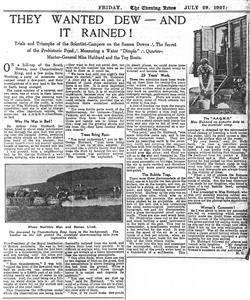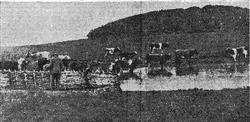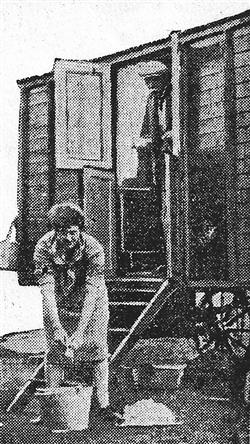They wanted Dew - and it Rained!
From a newspaper clipping in a copy of Neolithic Dew-Ponds and Cattle-Ways.
The Evening News Friday July 29th 1927
They wanted Dew - and it Rained!
Trials and triumphs of the Scientist-Campers on the Sussex Downs
The Secret of the Prehistoric Pond
Measuring a water “Dimple”
Quarter-Master-General Miss Hubbard and the Toy Boats
On a hill-top of the South Downs, near Chanctonbury Ring, and a few miles from Worthing, a party of scientists are camped round a dewpond; and their investigations of it may lead to the face of Earth being changed.
The camp consists of a caravan and two tents, one of which is their laboratory and the other the sleeping tent, full of camp-beds. The caravan, commissariat centre of the outfit, is ruled over by Miss Hubbard, daughter of the expedition; and she is also in charge of the other important vehicle, the motorcar. An A.A.Q.M.G.-Chauffeuse, in fact.
Why He Was in Bed
Dr. Arthur John Hubbard, her father, tried to shout some information to me through the gale that was pouring over the humped downs, sweeping great white clouds up from the distant blue band of the sea horizon; but human breath could not prevail against breath of heaven, so we retired into the sleeping tent and sat on a camp bed.
I was greeted, from a neighbouring bed, by Mr. George Hubbard, a well-known scientist, who was for some time Vice-President of the Royal Institution of British Architects. He was in bed for the prosaic reason that he had been caught in a thunderstorm that morning and was waiting until his niece pronounced his clothes dry at the caravan stove.
"That thunderstorm," I was told, " raised the level of the dew-pond nearly half an inch - we can measure the water level to a 2,500th part of an inch-adding nearly six tons of water in six minutes. And the pond being on a hill-top, no water drains into it: all that weight of water fell on the surface and margin of the pond itself."
This illustrates the difficulties under which the observations are being made - they want to find out about dew, not rain - and the weather has been as unkind to them as it could be.
"We have had only one night's dew since we started," said Dr. Hubbard. " A clear sky is what we need, for a blanket of cloud stops radiation and there is no dew. It is most important that we should discover the secret of dewponds; in fact, it is of worldwide importance, because once we are able to secure the deposition of dew, we could reclaim deserts, provided the atmosphere there contained sufficient moisture.
"The once fertile parts south of the Mediterranean, for instance Timgad, Palmyra, and so on—are now desolate, because they have been deforested. Goats and camels are to blame for this: they eat the growing shoots, and the trees die: they have created their own deserts."
Trees Bring Rain.
You must understand," put in Mr. George Hubbard, " that trees bring rain." I sat up at this, amazed. It sounded like a child's theory that trees make the wind by fanning the air; but the scientist was perfectly serious. “The leaves," he explained, " are thermally isolated from the earth and radiate their heat - very quickly. It is difficult to explain why but leaves and grass are always at a lower temperature than the surrounding atmosphere."
“One often finds, when there are one or two degrees of frost on the grass, that the temperature is above freezing point five feet from the ground. When a moisture-laden wind blows through leaves it is cooled and deposits its moisture." "You can very often see that up here," said Dr. Hubbard. " To windward of a clump of trees the air is clear, while a heavy mist. streams away from the other side of them.
“Now, if we could make dewponds in desert places, we could nurse trees into existence, and the desert would be watered and become fertile.
25 Years' Work.
These two scientists have been working on these lines for twenty-five years - the others are archaeologists - and they have written what is probably the only book on Neolithic dewponds, for, strangely enough, prehistoric man could make dewponds. There are many on the downs, some of which remain full of water to this day.
A line of hurdles ran from the margin of the dewpond to the laboratory tent. This was to protect a thin lead pipe from the inquisitive attention of down-land cattle. The pipe syphons the water into a small square tank inside the tent; and any rise or fall of level can thus be accurately measured at a surface unruffled by the wind.
"This pond," said Dr. Hubbard, "was made forty-five years ago, and it has always contained water. They are made by removing earth to the necessary depth and covering the exposed surface with four inches of straw. Then a layer of clay, eight inches deep, is spread over the straw; and flints are put on to the clay and trampled in. The clay must be watertight. Dewponds are most successful on hilltops, because the air is more rarefied and therefore colder and more nearly approaching dewpoint.”
The Bubble Trap
There were three thermometers at the pond, one on a hurdle two feet above the surface, one at the margin, and one attached to a string, at the bottom of the pond; and their readings are recorded every hour. Halfway up the pipe was an upright glass tube, which acts as a bubble-trap and prevents the syphon being choked by an air-bubble. At the side of the tent was a box containing the usual meteorological instruments, barograph, wet and dry thermometer, and a grass thermometer stood underneath. These are also read every hour.
Mr. Dombraine came out of the tent and stood holding a small instrument in the teeth of the gale. This was an anemometer, a speedometer worked by a fan revolved by the wind. It measures the speed of the air to a millionth of a foot per minute, when an allowance has been made for the friction of the little wheels inside. We went into the tent and examined the micrometre, which measures the rise and fall of the pond's water level to a hundredth of a millimetre. This accuracy is obtained by the micrometre: wheel raising or lowering a hook under, the water, until its point causes a dimple in the surface skip of the water.
"My own theory, said Dr. Hubbard, is that a Neolithic pond was made here and for some reason failed. I can hardly walk round the margin without finding flint chippings," He produced from his pocket a flint arrowhead and a flint shaped for boring he had picked up that morning. Undoubtedly the Roman camp in that wood was built over Neolithic earthworks; and dewponds are always found in the vicinity of these.
"What a lot of oysters the Romans ate," he added, " We have found thousands of shells. But the best discovery was made by my daughter, who found piece of a red Selman bowl, covered with figures.”
I was presented to Miss Hubbard, who was very sensibly wearing rubber sea-boots, the ground being saturated, and she gave me the photographs reproduced herewith.
Woman’s Comment!
As I was about to leave my astounded eye fell on something which momentarily made me doubt these scientists. In the corner of the laboratory tent two green-painted toy sailing boats, such as you can buy in the village post office. Had I hit on the true explanation of this camp? Was all the scientific apparatus a clever shield behind which these responsible scientists indulged a guilty appetite for toy boat sailing?
Dr. Hubbard followed my glance and roared with laughter. "My daughter gave us those," he said. "They are the woman's comment on our activities!”
M.D.
Where Neolithic Man and Roman Lived.
The dewpond by Chanctonbury Ring (seen in the background)
The hurdles on the left protect the scientists’ dew-measuring tube from the inquisitive cattle.
The “A.A.Q.M.G.” Miss Hubbard on domestic duty in the scientists’ camp.


